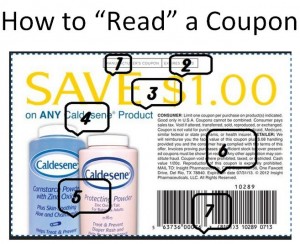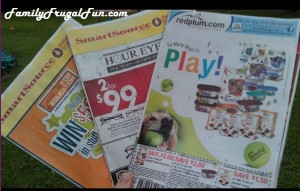Are you new to couponing but want to get in on all of the savings you’re hearing about? Well let me give you some top tips on how to coupon.
Have you ever wondered exactly how to “read” a coupon? Well that is the 1st thing you need to know is “how to read” a coupon. Seems pretty self explanatory but you’d be surprised how many people get it wrong.
This is one of the many things I go over in my “frugal school” frugal living seminars but I’d like to offer a refresher here below. I’m a frugal living expert. Be sure to bookmark this site and “like” us on Facebook.
- Manufacturer’s coupon (if it doesn’t state “manufacturer’s coupon) then its a Store coupon (for example Target coupons say “Target Web Coupon” and they are NOT manufacturer’s coupons
- Date of expiration (last day you can ethically use this coupon at any store
- Value of the coupon (for instance the coupon above has a value of $1.00
- What the coupon is for; This coupon is for ANY Caldesene product and you’ll note that there are full sized examples in the image however there are no size restrictions on this coupon (which means you may like to check for travel and trial size to snag a freebie to try out this product before you purchase a full size if possible)
- Product image (A coupon is “read” by the words NOT the picture. The image you see may be the item you purchase however the coupon states ANY Caldesene product so not just the one in the picture. Many people thing you have to buy whats in the picture and that is just not the case)
- Instructions for redemption. Did you know that stores submit coupons and get 8¢ above and beyond the face value of the coupon? Think about it for a minute….. If a Walmart store accepts 1,000 coupons for per day and they have 1,000 stores in the United states (this is just an example not actual numbers) then Walmart is taking in $80,000.00 per day in coupons! WOW!!!!!
- Bar code. This is how the scanner “reads” your coupon. A bar code that starts with a 5 will generally double (most of the time, unless otherwise stated) if your grocery store offers “doubles” (my East Coast Safeway,Giant, & ACME all double coupons up to 99¢ so a coupon with a value of 75¢ is worth $1.50 at any one of those stores. Check your local grocery to see if they double coupons too) A bar code number that starts with a 9 will generally NOT double (most of the time).
Next, you’ll need to know how to read coupon lingo on coupon matchups.
- SS- Smart Source Coupon Inserts
- RP – Red Plum Coupon Inserts
- PG – Proctor and Gamble Coupon Insert
- GM – General Mills
- WYB – When you Buy
- OOP – Out of Pocket
- ECB – Extra Care Bucks – available with your CVS Extra Care Card
Smart Source coupons, Red Plum coupons and Proctor and Gamble coupon are the names of coupon booklets that come in your Sunday newspaper. Not all areas in the United States receive all coupons. The coupons that come in your Sunday newspaper vary from region to region of the country. Some coupons are the same and some are not.
Look for grocery stores that double coupons. Many coupons in the Mid-Atlantic region double coupons up to 99¢ but most do not double coupons in say Florida for example. Find out the policy of the stores in your local region.




Leave a Reply